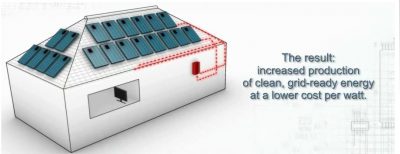
How is Israel ever going to meet its 10% renewable goal?
Israel with its population of 7 million hardly needs much total electricity. Only 40 Gigawatts (40,000 MW). To get 10% of its power from renewable energy, as it has pledged to do by 2020 – would take only about 4,000 MW of renewable power. Most of it will have to come from solar: there’s only 600 MW of wind potential.
So a mere 5 MW solar project is an exceedingly unambitious step towards the total 4,000 MW needed, and we are just 9 years from 2020.
And that 5 MW solar project (4.9 MW to be exact) pioneered by the Arava power company at Kibbutz Ketura is the only solar project begun. For such a developed nation, the lackadaisical approach to the goal is almost laughable.
The sad thing is that it is the work of Israeli inventors and engineering talent that blazes new trails worldwide in solar power. Israeli companies, from the solar hot water firm Chromagen, to (the now Siemens-owned) Solel, to the invisible solar window inventor, Pythagoras – all go overseas to succeed in business.
At the utility-scale, Israel’s Luz pioneered an entire industry, the model that all the other solar thermal projects worldwide benefit from; from Spain and Portugal to California.
It is the technical pioneering by Luz, which successfully operated the first solar thermal project in the world in the California desert – pumping out Californian power since the 80’s – that is the kernel from which the US company BrightSource has grown.
Gigantic EU companies like Iberdrola and Abengoa have grown rich on the idea pioneered by Israel’s Luz, yet Israel itself lags far behind.
What is it that holds Israeli renewable energy back? It is not the lack of brains.
It is bureaucratic failure. While not out and out corrupt like the US which allows corporate bribery, Israel does have real obstacles to renewable development, because it has not created the political organization needed to handle renewable energy.
The developer of that one tiny 5 MW project, Yosef Abramowitz, had to practically reinvent the wheel to get his solar kibbutz project going. It took him four years of battling Israeli bureaucracy.
“It was a question of extreme incompetence,” Abramowitz said. “We had to overcome more than 25 separate battles with various government departments, including the introduction of new legislation through parliament and a government decision. There are 17 government ministries involved in the issue that have no communication, no coordination whatever.”
Although 60% of Israel is vacant land, the 4/5ths that might be usable (one fifth is protected nature reserve) has been set aside for the military. But military bases are not at all incompatible with solar installations.
In the US, some of the largest solar projects are on military bases. It helps that President Obama signed an Executive Order commanding all the federal agencies to reduce their greenhouse gases 30% by 2020. The Department of Defense was among the first to step up.
In the US, Renewable Energy Standards at the state level are the driving force behind renewable development – in blue states. Our red states don’t pass progressive legislation. These include a stick of hefty fines if utilities don’t meet the targets. In Israel… not so much. Although the 10% by 2020 pledge has been signed, there is no legislative mechanism in place to make it happen.
As someone who is dismayed by the corruption here in the US that hampers renewable development, it’s sad to find out that things are no slam dunk in other nations, either.
More on what slows Israeli renewable development:
Israel Offers a Too-Low Rate For Wind Feed-in Tariff
Israel’s Grid Will Never Handle Renewable Energy Goals




While I do not agree wuthg your logic, I finally came up with similar numbers. In 2015 enegry demand is going to be around 15GWH(peak) and probably around 12GWH average over the day. 12GWH * 24 = 288GWH for a day. 10% for renewable energy will be around 30GWH. Assuming that there are only 10 good hours of light in a day, Renewables must be able to produce 3GWH. Assuming that not every day is going to be sunny, renewables must be able to produce 4GWH to keep up with 10% of total energy production.
My projectioans are for year 2015. What happen if energy consumption is going to rise despite effords to stop it. I do not nkow if Israel has enough free space to be able to produce 6GWH-10GWH with current technology.
Maybe you should explain it to people(in the article or comments). With 12GWH of maximum production capacity, how 40GWH is total power need? Something does not add up.
“With 12GWH of maximum production capacity, how 40GWH is total power need?”
You now call it GWH, not GW. That may be what is causing the confusion.
GWH or gigawatt hours are much different (and a larger number) than GW or Gigawatts of power. Total power is expressed in GW. It is the size of the power station(s) needed to supply a certain number of gigawatt hours annually, or daily, whatever.
Here’s an personal example. I needed to make 15 kilowatt hours a day between sun-up and sun-down from my own solar roof, for example (to supply total energy use of 550 kilowatt hours a month, ~6,600 kilowatt hours a year). But the size of the system to make that number of kilowatt hours a month is just about a 4KW solar system. (My own is a 3.15 KW system, designed to supply about 80%, to substitute just the expensive tiers of my electricity)
All the numbers seem confusing: 4 KW (kilowatts) versus 500 kilowatt hours, etc… which is it? It’s KW. The system size, whether for a single home like mine, or for an entire country, is the number to look for, and that is not expressed in hours, or in peak use, but in just KW, MW or GW. (Or kilowatts, megawatts or gigawatts)
If anything is added, like -hours, or -peak use, that is referring to production or the power output, not the system size.
Aslo good resource ot enegy capaciry for Israel and region
http://www.eia.gov/cfapps/ipdbproject/iedindex3.cfm?tid=2&pid=2&aid=7&cid=r5,&syid=2004&eyid=2008&unit=MK
http://www.jpost.com/Sci-Tech/Article.aspx?id=209456
For interim 1,5GW licencing goals by 2014.
Maybe links can not be posted
http://www.globes.co.il/serveen/globes/docview.asp?did=1000595463&fid=1725
for energy generation capabilities.
Ok, I am reposting.
http://www.jpost.com/Sci-Tech/Article.aspx?id=209456
1,5GW is interim goal for 2014.
Your source is wrong. in peak times of 2010 Israel consumed around 12GW an hour. Read this article
http://www.globes.co.il/serveen/globes/docview.asp?did=1000595463&fid=1725
IEC can produce about 10GW. I also read that there are 2GW in private capacity.
Thanks, Boris. Peak use is different than total power need. I still think the 4 GW as 10% of total power needs is good indicator, but as you point out, it looks like the 1.5 GW by 2014 is a good step. Lets hope it happens
I do not know why my last comment is not up.
Where did you get 40GW? In the summer, during peak times, Israel consumes 12-13GW. In couple of years(end of 2013) with 3 new large Water Treatment plants coming online and about 100K electric cars on the road, peak electricity will be around 15GW.
Yes bureaucracy was terrible. But all problems were from one beuarocratic hook: you could not build solar plant if you did not have expertise of doing so in Israel. Of cause nobody has expertise.
Now, excluding few negotiations on prices, thing are moving pretty fast. There have been 500MW worth of licences granted so far(not all solar). And by the end of 2014, there will be granted 1,5GW worth of licences. This means that at least 1,5GW of renewable energy will be built by 2020 at minimum.
I deduced it from my source that 4 GW was needed to supply 10% of Israel’s power. (10 times 4 GW = 40 GW)
But that is cheering news, indeed, that 1.5 GW will be approved by 2014. What is your source?